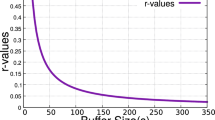Abstract
The application of biologically inspired algorithms to multimedia repurposing systems in heterogeneous network environments is gaining importance due to its ability to adapt and customize multimedia content to frequently changing network environments. This paper presents a biologically inspired proxy-based multimedia content adaptation system, which is used to repurpose multimedia content dynamically for the transmission over heterogeneous networks and end devices. We use a series of repurposing proxies’ services in a chain fashion between the sender and multiple end devices. In order to find the appropriate chain of repurposing services that satisfy the Quality of Experience (QoE) requirements, the proposed service selection algorithm uses the ant colony metaphor. During the communication session, the algorithm uses biological foraging behavior inspired from ant agents to find optimal service paths between the media sender and the destination. Experimental results demonstrate that the proposed algorithm provides significant performance gain over traditional, state of the art selection algorithms and saves the average delay.
Similar content being viewed by others
References
Hossain, M.S., El Saddik, A.: Multimedia content repurposing in wireless environment. In: Furht, B. (eds) Encyclopedia of Wireless and Mobile Communications, CRC Press, Boca Raton (2007)
Dijkstra, E.W.: A not on two problems in connection with graphs. Numer. Math. 1, 269–271 (1959)
Cormen, T.H., Leiserson, C.E., Rivest, R.L., Stein, C.: Introduction to Algorithms. 2nd edn. MIT Press, Cambridge (2001)
Di Caro, G., Ducatelle, F., Gambardella, L.M.: Building blocks from the biology for the design of algorithms for the management of modern dynamic networks. ECRIM (2006)
Di Caro, G., Dorigo, M.: AntNet: distributed stigmergetic control for communications networks. J. Artificial Intell. Res. (JAIR) 9, 317–365 (1998)
Dorigo, M., Di Caro, G., Gambardella, L.M.: Ant algorithm for distributed discrete optimization. Artificial Life. 5(2), 137–172 (1999)
Rosenberg, J., et al.: SIP: session initiation protocol. IETF RFC 3261 (2002)
Schulzrinne, H., Casner, S., Frederick, R., Jacobson, V.: Real time protocol (RTP): a transport protocol for real-time applications (2003). ftp://ftp.rfc-editor.org/in-notes/rfc3550.txt. Accessed Dec. 2006
Jain, R.: Quality of experience. IEEE MultiMedia 11(1), 95–96 (2004)
Hossain, M.S., El Saddik, A.: Proxy-based visual content repurposing using selection algorithm. In: IEEE ICONS 2007, Martinique, French Caribbean (2007)
Garey, M.R., Johnson, D.S.: Computers and Intractability: A Guide to the Theory of NP-Completeness. W.H. Freeman, San francisco (1979)
Jain, R., Rowe, L.: Acm sigmm retreat report on future directions in multimedia re- search. ACM Trans. Multimedia Comput. Commun. Appl. 1, 3–13 (2005)
JMF:Java Media Framework API (2003) http://java.sun.com/products/java-media/jmf/index.jsp, Acceesed Dec. (2006)
Caro, G., Ducatelle, F., Gambardella, L.M.: AntHocNet: an adaptive nature-inspired algorithm for routing in mobile ad hoc networks. Euro Trans. Telecom. (ETT) 16(5), 443–455 (2005)
Di Caro G., Dorigo M.: Two ant colony algorithms for best-effort routing in datagram networks. In: 10th International Conference on Parallel and Distributed Computing and Systems, Las Vegas, Nevada (1998)
Information Technology—JPEG 2000 Image Coding System–Part 3: Motion JPEG 2000, ISO/IEC 15 444-3 (2002)
Video Coding for Low Bitrate Communication. ITU-T Recommandations H.263 (April 2005)
Babaoglu, O. et al.: Design patterns from biology for distributed computing. ACM Trans. Autonom. Adaptive Syst. 1(1) (2006)
BISON Project. http://www.cs.unibo.it/bison/links.shtml, Accessed Dec. 2006
Suzuki, J., Suda, T.: A middleware platform for a biologically inspired network architecture supporting autonomous and adaptive applications. IEEE J. Selected Areas Commun. 23(2), 249–260 (2005)
Lee, C., Champrasert, P., Suzuki, J.: iNet: A biologically-inspired adaptation mechanism for autonomic network applications. In: IEEE Upstate New York Workshop on communications and Networking. Rochester, NY (2005)
Wedde, H.F., Farooq, M., Zhang, Y.: Beehive: an efficient fault tolerant routing algorithm inspired by honey bee behavior. In: ANTS Workshop, LNCS 3172. Springer, Berlin (2004)
Rajpoot, N. et.al.: A novel image coding algorithm using ant colony system vector quantization. In: International Workshop on Systems, Signals and Image Processing (IWSSIP’04)(2004)
Hu, X., Wang, T., Li, D.: A New Approach of Color Quantization Based On Ant Colony Clustering Algorithm. In: International Conference on information Technology: Coding and Computing (ITCC-05). Las Vegas, Nevada, USA (2005)
Ziane, S., Melouk, A.: A swarm intelligent multi-path routing for multimedia traffic over mobile ad hoc networks. In: 1st ACM international Workshop on Quality of Service and Security in Wireless and Mobile Networks Montreal. Quebec, Canada (2005)
Liu, Z., Kwiatkowska, M.Z., Constantinou, C.: A biologically inspired QoS routing algorithm for mobile ad hoc networks: In: Advanced Information Networking and Applications (AINA-2005), Taipei, Taiwan (2005)
Author information
Authors and Affiliations
Corresponding author
Rights and permissions
About this article
Cite this article
Hossain, M.S., El Saddik, A. A biologically inspired multimedia content repurposing system in heterogeneous environments. Multimedia Systems 14, 135–143 (2008). https://doi.org/10.1007/s00530-008-0124-2
Published:
Issue Date:
DOI: https://doi.org/10.1007/s00530-008-0124-2




